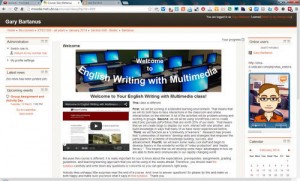When I first began brainstorming ideas about this Moodle module/course, I was thinking in terms of creating, from scratch, a brand new course that would be similar in name and topic only to the courses that I am teaching now or have taught in the past. I assumed that I was going to have to come up with entirely new content and learning activities just so I could be authentic. In other words, I was dealing with a foolish notion that, by using any of my previous materials (and prior knowledge!?), that I would somehow be “plagiarizing myself” and that I would be pedagogically sinning.
Thankfully, I took a few minutes to read through several posts in the Discussion Forum and came across Natasha’s comment that our Moodle project should ideally be as close to real life work as possible. After thinking it over for a few minutes, I came to realize that the purpose of this assignment is not so much to force us to develop new course material as it is to help us become familiar with how course material can be integrated with the kinds of affordances that are offered by an LMS such as Moodle. And that’s when I finally began to make some headway on this assignment.
After expending a considerable amount of time and frustration on trying to conceptualize an imaginary class based in Vancouver, BC, and comprised of mainly Canadian students whose first language is English, I freed myself of that arduous waste of time and decided to just adapt the “English Writing with Multimedia” course that I developed and taught last year at Hanyang University in Korea. This class is comprised mainly of Asian students and their first language is rarely English. So it’s an ESL class!
More specifically, it is an advanced English Writing class that is taught in a blended environment. We meet for about 100 minutes only once per week and the rest of the work is done online. I have been using the Canvas LMS plus a WordPress site to provide much of the “online” part of the environment. My students have been using WordPress.com to set up their required ePortfolios (blogs).
The only major difference in my Moodle course is the fact that the LMS is Moodle. I’ve also come across new material and developed a few new ideas that will work in the real life class, so they are now being tested in the Moodle version. Those include the talking avatar, the Sundance/YouTube video featuring Casey Neistad, and the forum assignment that is connected to the Sundance/YouTube video.
I hope that, in the near future, we ETEC565A students will be able to enroll in one another’s classes and provide feedback. I set up my own Moodle course so that anyone can self-enroll and I invite everyone here to please do so, if you have time and interest. (Thank you, Andrew, for having already done so!)
By working through one another’s Moodle courses, we will be able to get new ideas and give some positive affirmation to those who have implemented them. We may also find good reason and opportunity to discuss possible enhancements and/or changes to some of the content. This will be such a huge benefit to everyone and I’m really looking forward to getting started on that, if possible. For my own course, I’d be particularly interested in some feedback on the talking avatar. I hadn’t considered using one for the Moodle page because I’ve never heard any positive feedback from my students in Korea when I’ve used one on their course pages. But the trainer in the Moodle tutorials I’ve been using said that she has had better results with an avatar than with showing her own face in the welcome video on her Moodle sites, so I thought why not give it a try here.
I also want to point out that the red “bilingual language requirement” and “grade review policy” boxes that are prominently displayed in the syllabus would, in my opinion, both be regarded as too condescending to be used in North America. But they are both necessary here in Korea because a) students rarely read the syllabus before enrolling in a class and cannot understand English b) most Korean students think nothing about asking, begging, or even attempting to engage in bribery for higher grades. It’s one of those rare cultural differences that I (and most foreign teachers) truly despise and the big red boxes are just our way of discouraging such inappropriate “language gaps” and “grade-bargaining.” (The latter issue is really tough for me personally because students feel so much pressure to get A+ in every class that they sometimes self-destruct if things don’t work out that way for them. Sadly, in my first year of teaching at a Korean university, I lost one of my favorite students who committed suicide because of a fight with his girlfriend and I still get emotional today when I think about him.)
Thank you for taking time to read this and I look forward to seeing more colleagues self-enroll in my Moodle course. Also, please don’t hesitate to enroll me in yours, if you want some feedback from me!
Gary

